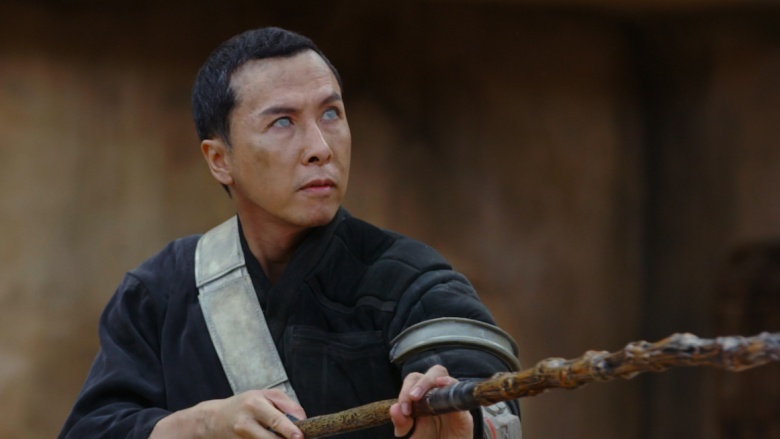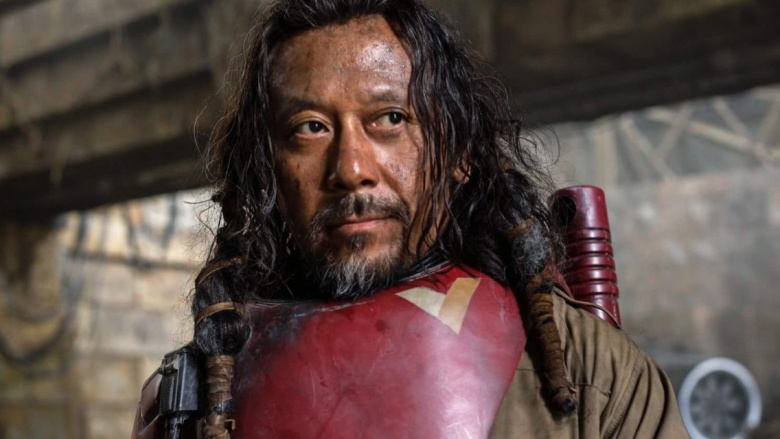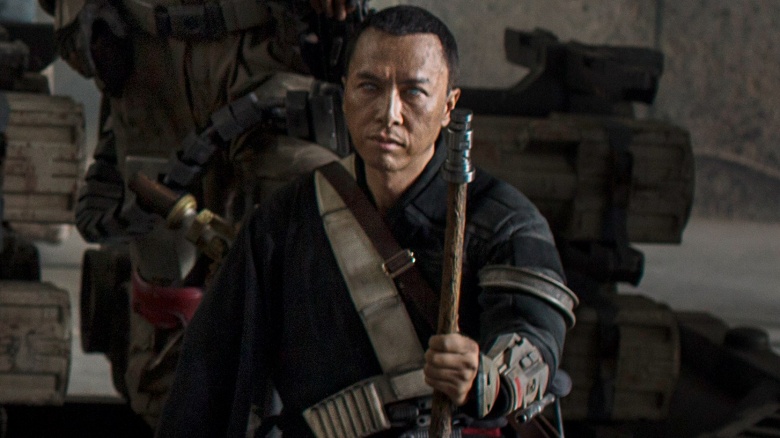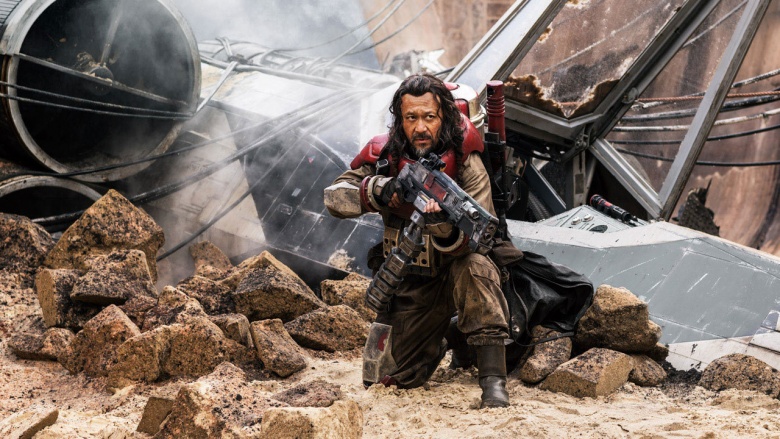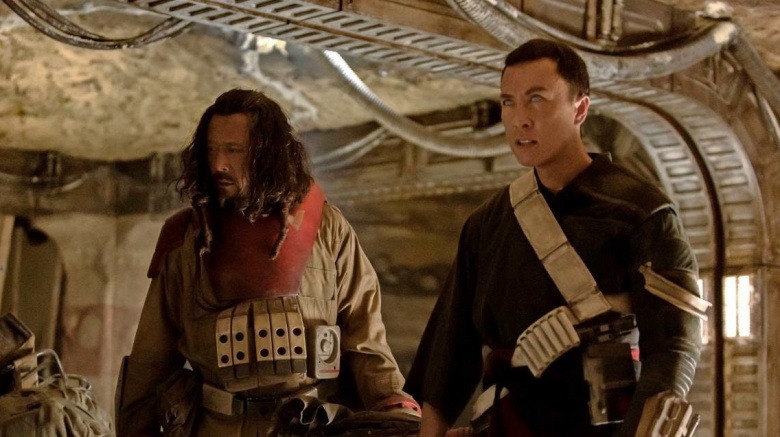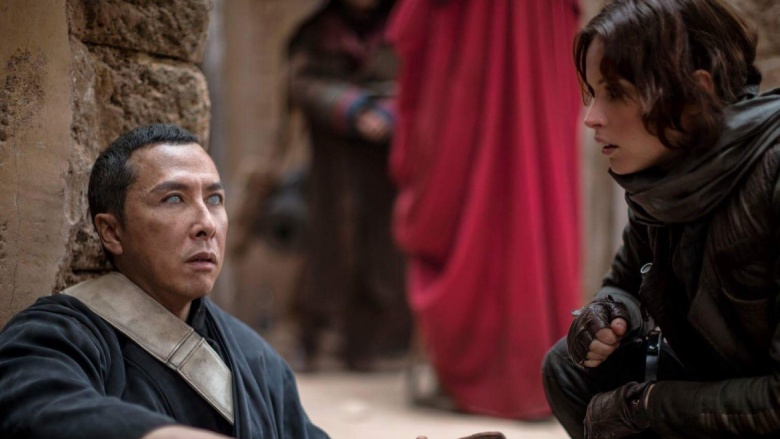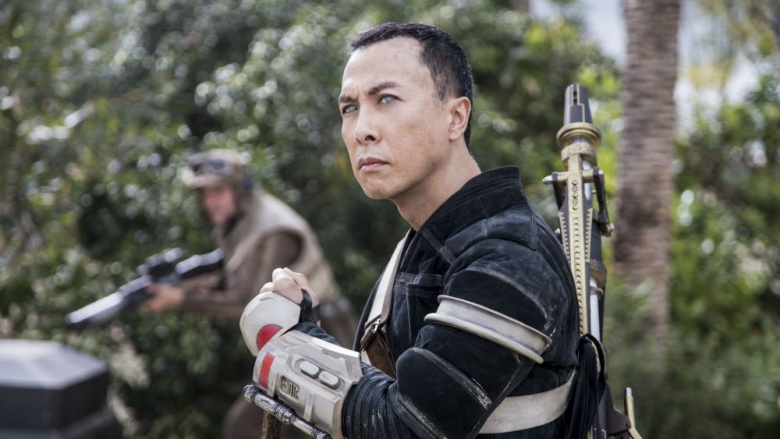Theories About Chirrut And Baze's Backstory
Rogue One might've been, at its heart, a connective tissue tale of how a pair we'd never heard of before — Jyn Erso and Cassian Andor — accidentally lead a ragtag team of rebels on the mission that put the Death Star's fatal flaw into the Alliance's hands and kick-started the events of A New Hope. But beyond sewing up some of those plot points by way of key character reprisals and a bevy of Easter eggs, the movie also had some fun with introducing a handful of newcomers who may or may not have had any relationships with the stories we already knew. This is where it gets its designation as a stand-alone Star Wars story.
One twosome in particular, Chirrut Îmwe (Donnie Yen) and Baze Malbus (Jiang Wen), have arrived as a buzzy duo who've spawned a series of fan theories about who they are and how they came to be such close companions on the battlefield. Here are some of those postulates about Chirrut and Baze's backstory.
First, let's talk about the official descriptions
As with a lot of Star Wars characters, the official website's descriptions are sparse at best but relevant nonetheless. For Chirrut, the site tells us very little that we couldn't already surmise from watching him in action at the Battle of Scarif and his constant chanting of his prayer, "I am with the Force, and the Force is with me." The site explains that Chirrut is "deeply spiritual [and] believes all living things are connected through the Force." He's not a Jedi (so, the Force isn't actually with him), but he's been given another gift that's carried him this far: discipline. Because of his commitment to thriving despite his blindness, he's got some serious mental might going for him in any given fight. Check, check, and check again. That was all right there in the movie, no doubt about it.
Baze, meanwhile, is described as having a sense of "bravado," built by the fact that his home has been forcibly occupied by the Empire. What's a little more informative is this little nugget: he regards Chirrut as his "best friend and moral compass." Keep that particular turn of phrase in mind as we go.
Are (or were) they actually lovers?
One theory that's been gaining a lot of traction is that Chirrut and Baze were actually lovers. There's nothing concrete in the film to back up this idea (and, as indicated above, the official lingo of the characters' coinage doesn't indicate as much either). However, there were a few moments in Rogue One where they could just as easily pass for romantic partners as mere pals, based on the obvious sense of understanding they had for one another — consider when Baze explains Chirrut's repetitive prayer series to the others with nothing but respect for its purpose, albeit with a little of that "yep, that's him" familiarity any significant other might have for their better half's weird quirks. And let's not forget the part when the words "I don't need luck, I have you" are exchanged between them. The Hallmark card practically wrote itself right there.
Perhaps most convincingly, there's the matter of their final moments on the field at Scarif, when Chirrut braves certain death for the sake of tripping the master switch so that Jyn and Cassian can transmit the Death Star plans. Once he is, indeed, taken down by the Stormtroopers that surround the field, Baze blazes out onto the field with no real purpose other than to exact a little revenge against the fighters that took down Chirrut before succumbing to his own inevitable wounds ... and to hold his "best friend" in such a way as to say one final goodbye to him in this life, with a gentle cheek rub to boot. There was definitely a sense of longing and immediate grief in his eyes that resonated with viewers and justified the interpretation that this was more than just some ordinary bromantic moment of finality. And the fact that he was willing to go into an outright suicide mission for one last moment of togetherness speaks to something much more than just a platonic kinship between them.
For what it's worth, director Gareth Edwards didn't exactly deny the speculation, telling Yahoo Movies, "I don't mind people reading into [Chirrut and Baze's relationship]. I think that's all good. Who knows?" He also echoed The Force Awakens director J.J. Abrams' sentiment that the Star Wars pics including LGBTQ characters is a sensible recognition of the galaxy we live in. And it really is.
There's also an obvious history with the Whills
Before Star Wars was fully developed into what it was by George Lucas, he famously had an idea about the Whills, a group of wise men (and possibly women?) who watched the events of his intergalactic battle unfold from afar. In other words, these were to be the ultimate quasi-narrative perspectives of this whole shebang. So, for Chirrut to be introduced as a Guardian of the Whills, to explain his purpose of sitting around the Jedha marketplace and evaluating its passersby (like Jyn) in his mission to protect the city's Kyber crystal supply from Imperial intrusion, the name immediately seemed to relate to Lucas' original plans for this group.
From this movie we learn that the Whills might not actually have the innate benefit of the Force at their fingertips, but they've got an inarguable connection to that power of mindset and will. And, even without physical sight, they may know when their lives are of lesser value than the cause at hand. Because of Chirrut's official introduction as a Guardian of the Whills, and this preview of what these Guardians are like (not to mention the fact that Yen himself has indicated there's a lot more to the character's history than we ever got to see on-screen), there's a theory that we'll get to see more Guardians like Chirrut and maybe even some actual Whills somewhere down the line. If we do, it's likely that their intense strength and self-possession will be an asset to the Force in stories still to come. After all, the Force is with them, and they are with the Force.
Some think they're the pre-Han Solo and Obi-Wan Kenobi
Whether or not the relationship between Chirrut and Baze was made of any romantic threads, there are some who've interpreted their connection as being directly parallel to the bond that Han Solo and Obi-Wan Kenobi shared in the original films. For example, as the official character summary explained, Chirrut's devotion to the Force is owed to the fact that he believes it's the source of connectivity in the universe. You might recall a similar sentiment being shared by Obi-Wan, when he told Luke Skywalker in Episode IV that the Force is "an energy field created by all living things [which] surrounds us and penetrates us; it binds the galaxy together." As we know from the whole "I have a bad feeling about this" trope, Star Wars doesn't usually repeat a turn of phrase like this without intent.
Meanwhile, Han was far from sold on the idea of the Force being the backbone of all life and predestination but tolerated that viewpoint. And while we don't exactly get to hear Baze's thoughts on the subject — well, except for his tribute chant to commemorate his fallen friend in a final moment of glory — it's clear he's not quite as consigned to Chirrut's philosophy, but he doesn't begrudge his views either.
They're also meant to resemble another iconic duo from the franchise
Star Wars producer Kathy Kennedy confirmed to Entertainment Weekly that Chirrut and Baze are at least in part inspired by the 1958 Akira Kurosawa film The Hidden Fortress, which surrounded a pair of fighters-turned-prisoners who risk it all to protect a precious resource (the gold of a princess) from the (evil) powers-that-be. That could certainly have had something to do with why our new Rogue One besties — or at least Chirrut, with Baze's faithful backup — were charged with guarding Jedha's Kyber crystals from the Empire and hoping to save them for the Jedi, whose lightsabers were powered by the same resource.
They're certainly not the first Star Wars characters to owe their inspiration to Kurosawa's film. George Lucas has long credited the pic with being the crux of his Star Wars story construction as a whole. According to the BBC, Lucas even said in 2001 that it was the film's focus on the viewpoint of its "two lowest characters" that stuck with Lucas when he was devising his Star Wars schematics, particularly when it came to writing the droid duo R2-D2 and C-3PO. So although they clearly had blood running through their veins, Chirrut and Baze were meant to provide a similar perspective device as the droids did in the prior installments. Kennedy indicated as much herself by saying of the new pair, "You could even say to some extent it's, you know, R2 and C-3PO, a little bit of that."
Their allegiance to Jedha might hold a higher significance, too
As one of the first sites to experience the wrath of the Death Star, the city of Jedha is definitely no more. But before its bitter expulsion from existence, the beloved home of Chirrut and Baze is described by the official Star Wars databank as "home to one of the first civilizations to explore the nature of the Force," and it was "at one time a world important to the Jedi Order." The history of how it came to be occupied by the Kyber crystal-hungry Empire could be as rich and ripe for exploration as Chirrut and the Whills' backstory well beyond the events of Rogue One and its novelization. So, it wouldn't be too much of a surprise to see a prequel visit to this wintry moon in its Jedi-allegiant, spiritual pilgrimage-heavy heyday with Chirrut and Baze having a place right in the thick of that grand scheme. Hey, anything to get more of these guys on the screen, right?
Chirrut might also have a connection to Kanan Jarrus from Star Wars: Rebels
We know that Chirrut's blindness was something he had to overcome through sheer force of will, and there are some who believe he may have taken a few pointers from Kanan Jarrus from Star Wars: Rebels, a Jedi Knight whose own inability to see was eventually no hindrance to his service to the Force. In fact, such a history between those two could explain why Chirrut is such a devoted Force fanatic and believes that it is, in some ways, with him. If this theory were true, Chirrut wouldn't be the only (Force-sensitive?) human Kanan would take under his mentoring wing, and the timeline would make sense since Kanan's lightsaber-strike-based blindness also transpired before the Battle of Yavin. Could they come into play in Rebels, too? Again, anything's possible at this point, but given the fanfare surrounding the pair, it wouldn't be a huge stretch to Yoda-predict that happen it could.

